Effective Workload Management: How to Organize Team Work & Keep Resources Under Control
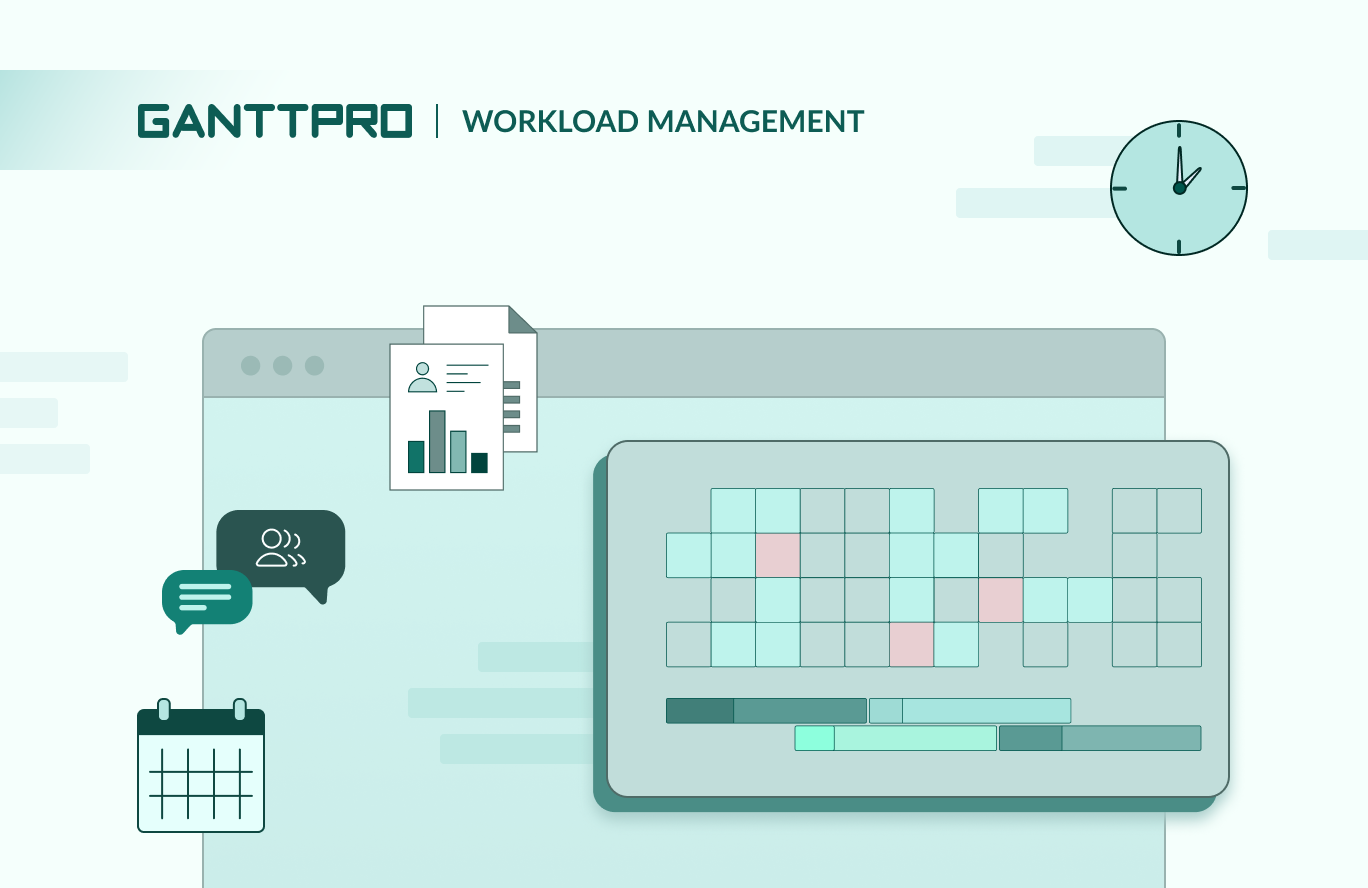
Audio version:
Implementing any project involves many important processes, including careful workload management.
One of the critical duties of project managers is to ensure that their team’s workload is well-controlled and balanced. It can be achieved through rigorous training, sufficient experience, and the use of smart resource management tools with workload control functionality.
Let’s start this article with the workload management meaning and definition and then delve into the details as well as a real-life workload management example.
Contents:
- What is workload management?
- Why is workload management important?
- Workload challenges and ways to manage them.
- What are the benefits of workload management?
- How to improve workload management?
- Workload management example.
What is workload management?
Workload management is the process of distributing and managing tasks and resources across a team or company. It is aimed at optimizing productivity and ensuring a balance among responsibilities.
This strategic process usually involves task distribution, asset prioritization, capacity management, overburdening prevention, and more. It enhances overall organizational performance, reduces employee burnout, and improves job satisfaction.
Kasia Richter, a cross-cultural psychologist and founder of Wellbeing Strategist adds some simple yet essential details to this definition:
The nature of workload significantly affects productivity within an organization. A balanced workload allows individuals and teams to function optimally, meeting deadlines and maintaining a high quality of work. Conversely, an excessive or poorly organized workload can be detrimental to productivity.
Why is workload management important?
Unhealthy workload planning is often the cause of project failures and dissatisfied teams.
According to the Gitnux report (2024), 39% of employee stress in the USA is caused by workload.
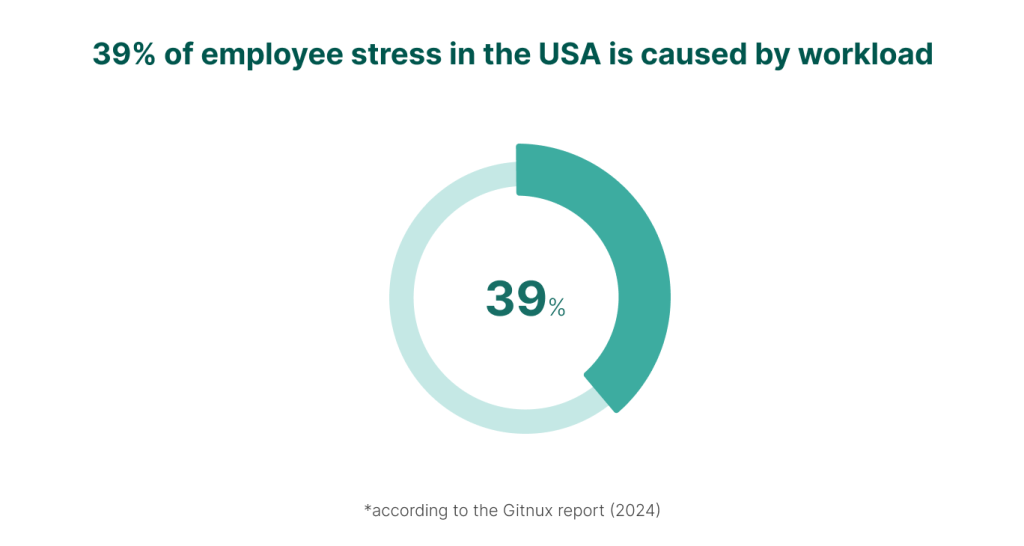
On the other side, detailed workload management increases productivity and helps maintain a healthy balance between work and personal life. Therefore, experienced managers strive to focus on the importance of workload management and make a resource management plan as efficient as possible.
It’s crucial to understand that workload management is not only about getting things done but also about getting them done smartly and sustainably.
Let’s discover some essential points why workload management is important.

- Helps to set priorities. Prioritization assists in determining the order and importance of tasks. It helps companies focus on the most critical and time-sensitive activities first, ensuring that assets are allocated effectively and that vital objectives are met on time.
- Enhances time management. Proper workload management is closely tied to the concept of time management. By allocating specific time slots to tasks and sticking to these schedules, team members can work more productively and systematically. Time management also involves setting realistic deadlines and understanding the time required for every single work activity.
- Streamlines delegation. Another essential component of workload management is delegation. It involves assigning tasks to other teammates based on their skills and capacities. Advanced delegation not only lightens the workload of workers but also assists in team development by allowing individuals to learn new skills and take on more responsibilities.
- Influences on monitoring and adjustment. Workload management is an ongoing process. It requires regular monitoring and adjustment of a resource calendar. Therefore, keeping track of progress and being flexible enough to make possible changes are vital. It may include reassigning tasks, adjusting deadlines, or revising strategies to better align with the evolving needs of your project.
- Advances work-life balance. Project managers should always remember that a healthy work-life balance is also a crucial goal of workload management. By effectively managing tasks and project management resources, employees can save time for personal activities and relaxation. This balance is vital for maintaining mental and physical health.
These factors are certainly crucial. However, the importance of proper workload organization is also highlighted by possible challenges that periodically arise when someone tries to improve this process.
Let’s figure these issues out.
Possible roadblocks or how to manage workload challenges
Managers who work with workload organization and its control need to always remember that any well-managed project should align with business goals, meet quality standards, and deliver within the set budget and timeframes.
However, managing workloads is often easier said than done. Therefore, they should care about possible challenges that may arise in any industry and professional field.
One of the vivid examples is the educational sector.
The Workload survey conducted within the report by the University and College Union (2022) showed that workload remains unmanageable for a decent number of workers in all sectors. Around 1 in 10 staff reported that their workloads were entirely unmanageable.
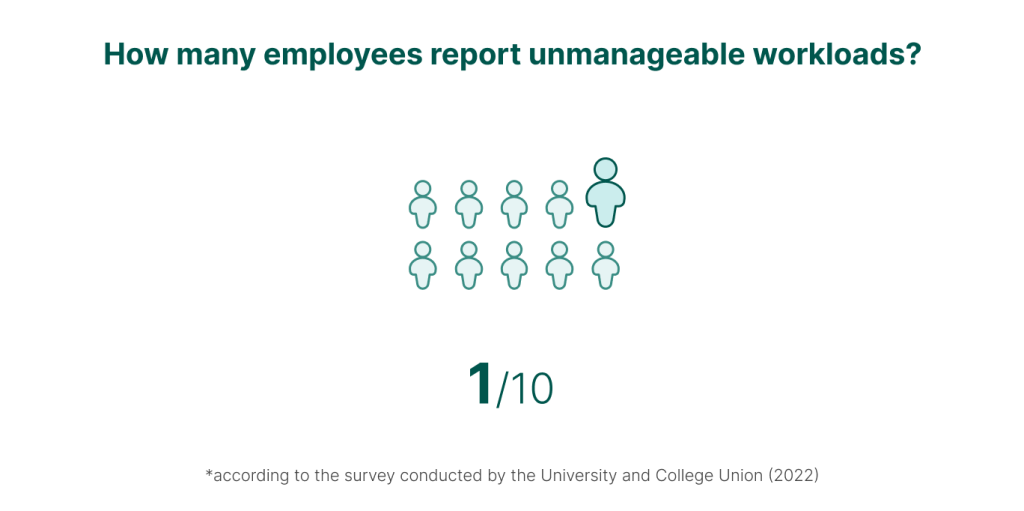
So, what are the common workload challenges and how can we manage them correctly?
- Resource overallocation. This common challenge occurs when employees are assigned more tasks than they can handle within the available time. Overallocation leads to reduced productivity, potentially missed deadlines, and burnout.
Solution: to manage overallocation, PMs should track workloads regularly and redistribute tasks as necessary. They should also consider hiring additional staff or adjusting timelines to relieve pressure.
- Unrealistic deadlines. Project teams often face tight deadlines. They can create unrealistic expectations for the team’s workload and result in increased stress and poor work quality.
Solution: to counter this, executives should negotiate realistic deadlines based on a project scope and team capacity. Breaking down projects into smaller, manageable parts will also help to meet deadlines more effectively.
- Lack of prioritization. When team members have no clear priorities, they often work on less critical tasks. It logically leads to inefficiencies, resource constraints, and project delays.
Solution: to solve this problem, managers should establish clear priorities at the initial stage of project planning and communicate them to the entire team. Regularly reviewing and adjusting these priorities is also important to reflect any changes in the project scope or objectives.
- Scope creep. This problem refers to continuous or uncontrolled changes in a project’s scope. A scope creep often leads to an increase in workload and resource strain. It can be a consequence of unclear project objectives or a lack of proper stakeholder engagement.
Solution: to address this challenge, a team should maintain clear documentation of project requirements and ensure any changes go through a formal approval process.
- Inadequate skills and qualifications. Sometimes, teams may lack the necessary skills or knowledge which can lead to inefficiencies and subpar work.
Solution: to address this issue, PMs should assess team capabilities and provide training or mentorship as needed. Hiring or consulting with specialists for specific activities can also be an effective solution.
- Internal communication breakdowns. Another common workload challenge is ineffective communication. It can lead to various errors, misunderstandings, and rework, increasing the project’s workload.
Solution: to mitigate this issue, it’s better to establish clear communication channels and protocols at the project’s outset. Team meetings, regular updates, and careful workload analysis will facilitate effective communication and ensure everyone is on the same page.
From the complexities and challenges, let’s move on to the benefits that come with proper workload management.
What are the benefits of workload management?
Workload management is not only about distributing project activities but also about optimizing the use of certain resources, enhancing productivity, and maintaining a balance that prevents employee burnout.
By carefully managing workloads, PMs can achieve a harmonious balance between their goals and the well-being of their employees.
Below we count the core benefits that professional team workload management comes with.
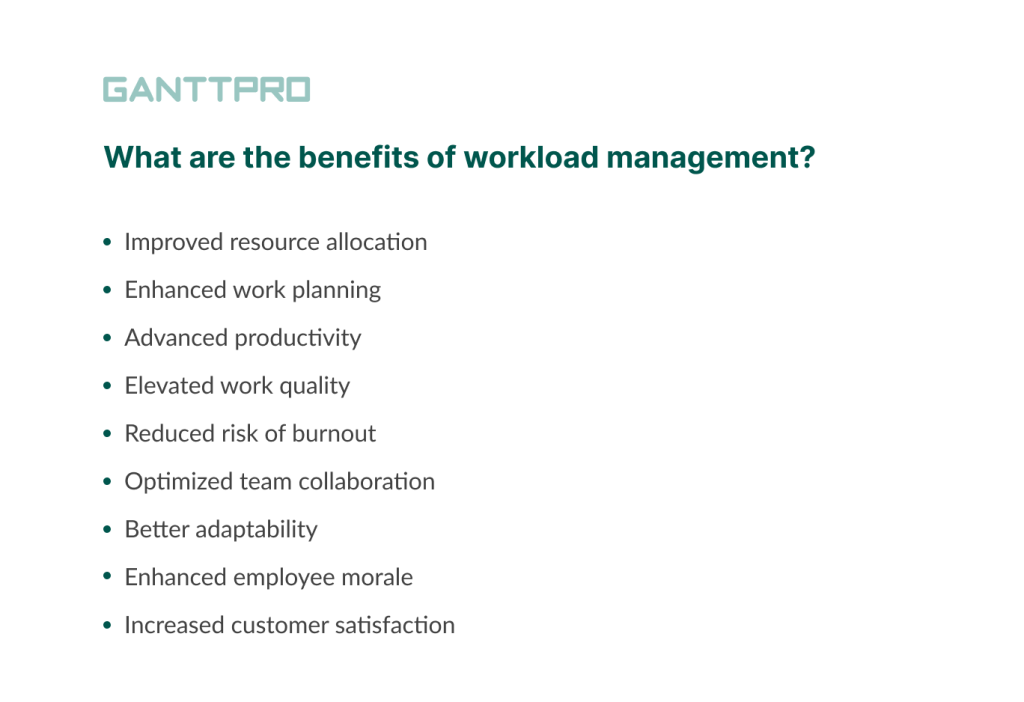
- Improved resource allocation. Proper workload organization helps utilize resources optimally, be it human resources or other assets. It leads to cost savings and ensures that resources are not wasted contributing to the overall financial health of the entire company.
- Enhancing work planning. Having a clear understanding of people’s capacity, managers can plan more effectively for future projects and business goals. This strategic advantage allows for better goal setting, forecasting, and long-term success.
- Advanced productivity. When project activities are distributed according to each team member’s skills and capacities, productivity naturally increases. It means that employees can focus on tasks that match their expertise that leads to faster completion of work.
- Elevated work quality. With a well-controlled workload, workers have enough time to focus on the quality of all work processes. This attention to detail leads to fewer errors and better outcomes. It can also positively impact the company’s reputation and enhance customer satisfaction.
- Reduced risk of burnout. By preventing overwork and ensuring that team members have a manageable workload, executives can minimize the risk of employee burnout. It will help reduce absence and employee turnover rates.
- Optimized team collaboration. Successful team workload management often involves redistributing tasks based on worker’s availability and skills. It can lead to better collaboration among teammates as they assist each other and share expertise, further boosting efficiency and team spirit.
- Better adaptability. If there is a well-managed workload environment, companies can easily adapt to different changes. Adaptability is key in any fast-paced business reality, and proper workload management supports it.
- Enhanced employee morale. Effective workload management guarantees that employees are not overburdened. It reduces stress, increases job satisfaction, and contributes positively to the overall work environment.
- Increased customer satisfaction. When work is well-organized and employees are not overburdened, the quality of a project constantly grows. It typically leads to accelerated customer satisfaction and loyalty, which is crucial for any business’s success.
Now that you know all about the main challenges and benefits of workload management, it’s time to look at the specific steps to optimize this process.
How to improve workload management: 8 steps to follow
Effective workload management may involve different strategic steps. They are aimed at fostering a positive work environment, boosting the overall quality of work, and promoting work-life balance.
Regardless of how the order of these steps changes, this process is all about working smarter and making sure each teammate contributes without becoming overwhelmed.
Let’s consider these consistent steps that will help you improve workload management and reach better outcomes.
1. Start with selecting a workload management tool
A company may contain various departments that can involve entirely different resources. It makes assigning a certain task or project to team members harder than it may seem.
It’s not the best idea if this company’s data is scattered across various tools and apps. It means that employees can waste valuable time tracking down necessary information related to their activities and assets, and every project will take longer than it should.
That’s why professionals strive to find all-in-one project management and resource scheduling tools with workload control functionality to avoid chaos and unnecessary actions.
Reliable workload management tools in combination with the applied resource allocation methods help optimize work processes and accelerate productivity. They simplify complex objectives and serve as good helpers for all employees.
With so many tools available, figuring out which workload management solution is right for your team is tough.
One of the platforms that deserve trust and respect is GanttPRO.
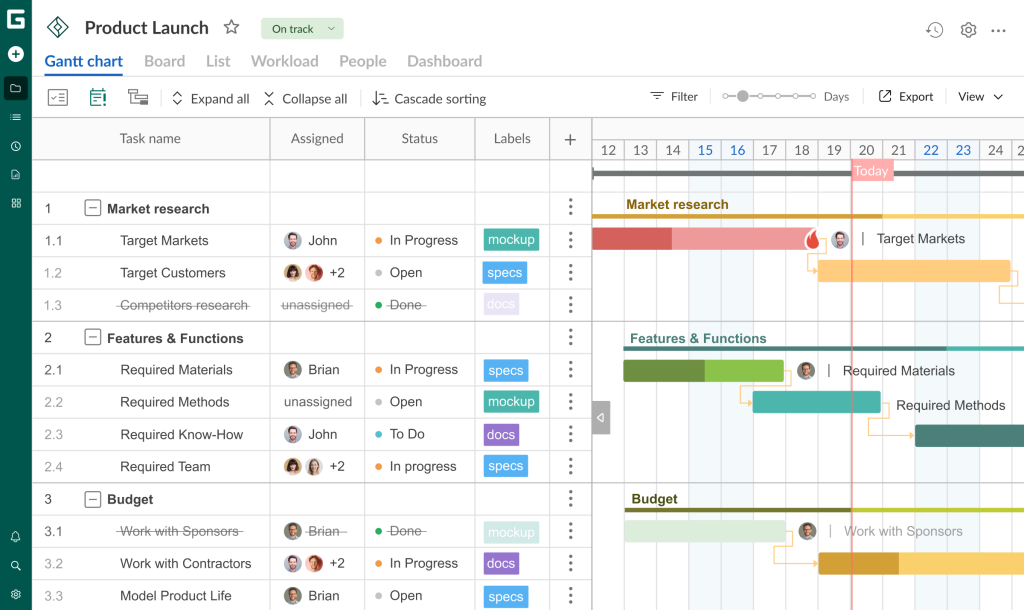
Project managers all over the world recognize the online Gantt chart maker as a powerful solution for creating project timelines, managing tasks, distributing work assets, and organizing workloads of varying complexity. Advanced resource scheduling and deadline control are also strong sides of the platform.
Project teams involved in software development, manufacturing, construction, events, healthcare, and other spheres rely on its robust Gantt chart with resource allocation and get undeniable results thanks to its power.
One of the vivid examples is Pacvac, a manufacturer of backpack vacuum cleaners (Australia), where Adam Hirsk, the head of product and R&D, uses GanttPRO’s features for various needs. Here are his thoughts:
The reason why GanttPRO is useful for us is that we do our own development which requires a lot of planning. So, we manage our product projects from an idea through to development and production and need to handle all the processes from the inception of design and ideas to manufacturing, testing, and further to sales, marketing, and customer support.
One more benefit of using GanttPRO is its professional ready-made templates.
If you’ve created a perfect schedule with a balanced workload and want to apply it for future projects, you can save it as a Gantt chart template and use it later when needed.
To make this long story short, if you strive to know how to allocate resources in project management effectively, manage tasks like a pro, and control workloads from A to Z, then GanttPRO is a brilliant option to consider.
2. Create tasks and delegate them effectively
Before coming to the workload management essence, teams need to divide their project into tasks and subtasks using a work breakdown structure. In this case, GanttPRO is also a wonderful assistant, because it is widely considered a professional WBS creator.
Understanding the strengths and weaknesses of all team members will help you delegate tasks accordingly. Effective delegation not only distributes the workload evenly but also empowers team members, giving them a sense of responsibility and ownership.
In GanttPRO, you can use the drag-and-drop feature to visualize task dependencies and place Gantt chart milestones. Since it’s a handy Gantt diagram, all data updates are in real time, so the entire team can see their new tasks in an instant.

Online workload management tool
Complete projects on time, allocate resources, and organize workload professionally.
Sign up for free3. Visualize resources
Resource visualization is the next essential stage after efficient task organization.
It’s better to store and visualize project management resources in one easily viewed location.
In GanttPRO, you can invite your team members, specify their roles, and set costs and calendars for them. It’s also possible to add and organize virtual resources (people, tools, equipment, etc.) there and even convert them into real users if needed.
4. Allocate resources properly
When you have a clear overview of everything your team needs to do, you can figure out who exactly will be working on what and when.
While assigning individual activities may seem straightforward, the general process of workload management can be quite complicated.
Proper resource allocation in project management will help you identify and assign specific team members or resources to tasks.
In GanttPRO, you can allocate one or several assets to each task. It’s possible to determine priorities, set estimations, and add task duration.
Also, the software allows for tracking time professionally, allowing all team members to log their working hours on specific tasks.
Project teams choose GanttPRO for planning, task organization, asset control, and workload management, acknowledging it as powerful resource management software.
5. Make workload management a must-have procedure
Clear workload visualization and its permanent balancing are what enable advanced scheduling and management of project assets.
GanttPRO allows for tracking resource workloads in a centralized way. It enhances task tracking and facilitates necessary adjustments in resource allocation to avoid underutilization or overloading.
Rostislav Chernichenko, the head of Infrastructure & PM of the DevOps team at GeoComply, a company that provides compliance and anti-fraud solutions, evaluates the workload management feature in GanttPRO in the following way:
It does not matter what plans and projects you are going to manage. There is one goal – to properly distribute work to team members and resources. With GanttPRO, we do everything right. The service perfectly allows us to see the resource workload.
GanttPRO’s workload management feature offers the following benefits:
- Monitoring assignees’ availability. The workload window in GanttPRO placed under a timeline enables you to keep an eye on the daily working hours or number of tasks allocated to each team member.
- Effortless task reassignment. You can utilize the convenient drag-and-drop functionality for swiftly redistributing tasks as necessary. An overburdened team member will be indicated by a red human icon.
- Customizable personal calendars. These calendars are particularly useful in managing intricate projects. They ensure you’re constantly updated about key dates and events such as time-offs, vacations, anniversaries, holidays, and more.
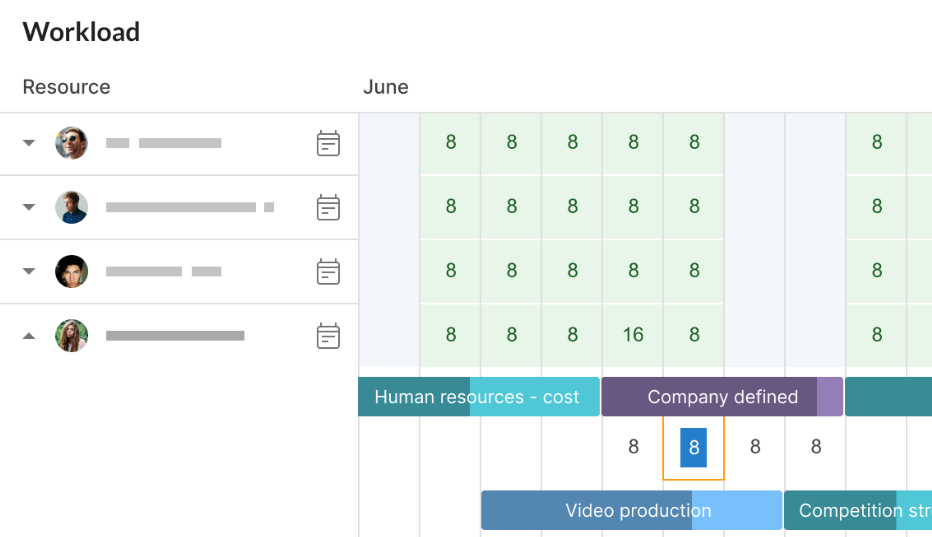
6. Prioritize team collaboration
Collaboration with a team is another key to success. So if you want to take the most out of your workload management system, don’t forget to communicate with your colleagues first.
Explain when you want to reallocate resources to balance work processes. As a result, team members may end up with a better work schedule.
GanttPRO lets you be aware of all assets due to the advanced collaboration means. It’s quite easy to get notifications, share documents, attach files, and communicate at any time there.
7. Care about clarity and healthy workload coordination
If employees feel that they’re constantly overworked, the whole team may quickly face burnout. Despite the efforts of PMs to improve the workload management strategy, perhaps, it’s high time to introspect.
The issue may relate to the culture of work coordination more than actual overload. Therefore, managers can pave the way by demonstrating what a healthy relationship with work looks like. A rather important point here is to find a way to avoid overworking and be able to communicate the bigger picture.
This idea is confirmed by Yaniv Shor, the author of the book “Time to Deliver”. He asserts:
One of the biggest reasons the majority of tech projects fail is because of lack of clarity. Every coordination required between different teams is a potential weak link, especially if everyone doesn’t have clarity on the bigger picture and the role they play in meeting milestones and achieving goals, or if resources are already strained”.
8. Be ready to reassign and make changes
If you think the hard part is over, you’re wrong.
Things tend to change even in the world of workload management. And the best attitude you can practice while prioritizing workload management is being ready to adapt.
Monitor workloads, try to identify any issues timely, and react. By keeping an eye on the essential processes, you can spot many challenges early and make the necessary changes to meet the project goals.
Do you want to dive deeper into a real-life example?
Real-life workload management example to inspire project teams
Let’s consider a simple workload management example in the marketing sphere. It can be a medium-sized agency where a marketing project manager is focused on improving a workload management scenario.
This agency has many clients with different marketing needs ranging from social media management and content creation to full-scale marketing campaigns. It’s quite logical that it has a lot of creative tasks and is constantly puzzled by resource planning for multiple projects.
A team includes:
- Boris, a marketing director.
- Ann, a project manager,
- Steve, a senior designer.
- Francheska, a designer.
- Tom, a content writer.
- Paul, a social media specialist.
- Alexandra, a PPC manager.
- Peter, a strategist.
Here’s what the process of workload management may look like.
Client onboarding
- Each client is introduced to a project manager who becomes their primary contact.
- The manager gathers all necessary information about the client’s needs and expectations.
Planning and delegation
- The PM breaks down the client’s requirements into specific tasks. It can be designing a logo or writing a certain blog post.
- These tasks are then assigned to the respective team members based on their skills and current workload using a project management tool.
Time tracking and deadlines
- Each teammate logs the time they spend on their tasks. It helps in tracking project progress and managing work hours.
- Deadlines are set for each task, and reminders are sent to ensure timely completion.
Updates and meetings
- The team holds weekly meetings to discuss project progress, upcoming deadlines, and possible roadblocks.
- The project manager regularly updates clients on the progress and receives feedback.
Resource allocation and adjustments
- If any team member is overburdened, tasks are reallocated to balance the workload.
- Additional resources or freelancers are brought in during high-demand periods.
Quality control and review
- Before any work is sent to the client, it undergoes a quality check by senior team members or the involved strategist.
- Feedback is collected and incorporated into the work.
Project completion and evaluation
- Upon completing the project or a set of tasks, the team reviews the work to identify successes and areas for improvement.
- Lessons learned are documented to improve future project management.
Feedback gathering and continual improvements
- Client feedback is gathered and analyzed.
- Based on feedback, the agency refines its processes and services.

This simple example showcases how a marketing agency can effectively organize and control workloads by breaking down tasks, assigning them to appropriate workers, tracking progress, and adapting as needed.
It is about ensuring that client needs are met efficiently while maintaining a balanced workload for employees.
Point your workload management towards success
Workload management is not a box-ticking exercise. This practice can be challenging. However, you can make the work easier and empower your results by implementing the appropriate strategies and using the right software.
One of the industry-leading project management platforms that looks perfect for organizing workloads is GanttPRO. It will help you deal with even the most complex projects, various resources, and teams of any size.
Frequently asked questions about workload management
-
Proper workload management typically involves the following five steps: setting clear objectives and priorities, planning and organizing, delegating tasks, monitoring progress, as well as reviewing and adjusting. These steps, when executed effectively, can lead to increased productivity, better time management, and a more balanced workload for individuals and teams.
-
The goals of workload management are primarily focused on optimizing the performance and efficiency of individuals and teams in a professional setting. The most evident goals include balancing workloads, increasing productivity, reducing burnout, enhancing employee satisfaction, improving time management, meeting deadlines, optimizing resource allocation, facilitating team collaboration, adapting to changing priorities, enhancing the quality of work, and more.
-
Yes, managing workload can be considered a skill. It involves a range of competencies such as time management, prioritization, organization, and decision-making. Effective workload management enables workers to complete tasks efficiently, meet deadlines, maintain a good work-life balance, and reduce stress. When managers have strong workload management skills, they can increase team productivity and project efficiency.
Read also
Join 800,000+ project managers!
Create Gantt charts in minutes with GanttPRO and reduce time spent on managing tasks by 40%
Try for freeNo credit cards required. No obligation.


